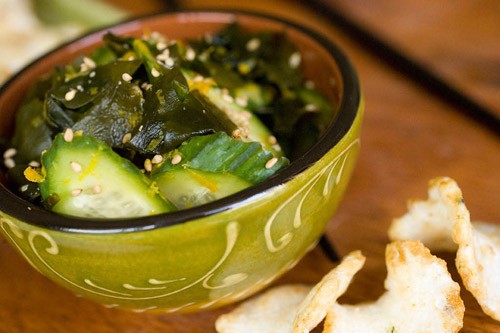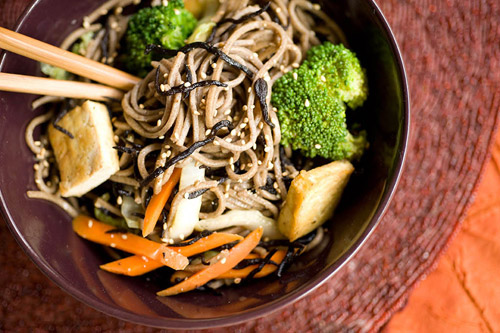Blissful Bites (38 page)

Sushi is the greatest thing to make with leftover rice. I usually put about one cup of rice per roll, pressed out very thin. Get creative and try different spreads and fillings in your rolls. Just be sure not to put too many fillings inside, because then your roll will be too big to fit in your mouth!
3 cups
pressure cooked brown rice
, on page 153
2 to 3 nori sheets
spread choices
Mustard and/or vegan mayonnaise
Umeboshi paste
Miso
Almond butter
Mock tuna
filling options
Carrot
Celery
Asparagus
Cucumber
Avocado
Tempeh or tofu
Sauerkraut or pickled shiso
Blanch veggies as needed. Fry tempeh/tofu, if using. Lay nori on sushi mat with lines going in a vertical direction. Keep a small bowl of water nearby to wet your fingers. Spread rice along
2
â
3
of the nori sheet, starting at the bottom and working up. There should be a space at the top with no rice. Wet fingers to help spread the rice evenly.
Lay down your spread, then the fillings, evenly across the bottom, about an inch up from the bottom of the nori. While holding the fillings in place, start to roll the bottom of the nori sheet up over the fillings while tucking them under. Continue to roll and tuck until you reach the end of the nori sheet. If necessary, lightly wet the end to help it stick closed.
Â
blissful tutorial
To see a tutorial on how to make sushi rolls, watch the video on my YouTube channel: www.youtube.com/user/theblissfulchef
“With every drop of water you drink, every breath you take, you're connected to the sea. No matter where on Earth you live.”
â Sylvia Earle, American oceanographer

orange-wakame cucumber salad
ââââââââ
Sea vegetables are an important missing link in the plant-based diet. They are readily available at natural food stores across the country, but that aisle is often neglected. I have to admit that sea vegetables are an acquired taste. When I first starting eating them, I could barely get them down. Now I have found ways to make them more appealing and appetizing. Each one has a different taste, texture, and smell. At the natural food store, you can find dulse, kelp, and nori shakers that make sneaking sea veggies into your diet very easy. Most of the recipes in this section are great for sea-veg newbies.
                       Â
Sea vegetables, or seaweeds, are some of the most nutritious foods we can eat. They have more vitamins and trace minerals per ounce than any other food. They are very alkaline, have antibiotic and antibacterial properties, aid in digestion, and help reduce cholesterol. You don't need to have a lot to get the benefits. Just a tablespoon or two a day will do the trick. Keep in mind that sea vegetables are usually dried and will double or triple in size once rehydrated. Be sure to drain off the soaking water and cook in fresh water. Also, buy your sea vegetables from a reputable source. They may be cheaper at Asian markets, but they also may contain fish by-products or unwanted chemicals.
Wakame is part of the kelp family. Often found in soups and light salads, it supports the liver and nervous system. Usually it comes in flakes or long strips. If you find it in long strips, use kitchen scissors to cut into
1
â
2
-inch pieces. For soups, toss in a pinch or two toward the beginning. For salads, marinate the wakame for up to 20 minutes.
Kombu, also known as kelp, is used mostly while cooking rice, grains, and soups as a flavor enhancer, to help aid in digestion, and to add trace minerals. It's good for the reproductive system, kidneys, and adrenal glands. Generally when cooking grains or beans, add a 1-inch piece of kombu at the beginning of cooking.
Most people recognize nori because of the popularity of sushi. Kids love it for its mild sweet and salty flavor. It has more vitamin A than carrots and is full of calcium, iron, and many trace minerals. It makes the perfect snack, and is beautiful as a garnish for soups, grains, or salads.
Dulse is one of my favorite sea vegetables. It's a good source of vitamins E, C, and B-complex and strengthens the blood, kidneys, and adrenal glands. It's red in color and does not require cooking. It either comes as whole leaves, in flakes, or in a condiment shaker.
Arame is lighter in taste than hiziki. It requires less cooking time and can be marinated for salads. It's a great source of calcium, potassium, and other minerals. It's usually found in long threads, while hiziki is usually found in smaller pellets or thicker strands. I find hiziki to be the strongest-tasting sea vegetable, so it's best when cooked for a longer period of time with other sweeter vegetables. Be sure to soak both of these before using and drain off the soaking liquid.

dulse-pumpkin seed condiment
![]()
![]()
![]()
![]() ⢠Makes about
⢠Makes about
1
â
2
cup
This is a very simple macrobiotic condiment that is so tasty and great to serve over grains, salads, or soups. It comes from my friends David and Cynthia Briscoe, who have an online cooking school that can be found in the resources section in the back of the book.
1
â
2
pumpkin seeds
1
â
2
cup tightly packed dulse (yields about
1
â
4
cup powdered dulse)
Unfold dulse and check for seashells and stones. Spread dulse on a cookie sheet and bake at 350 degrees F for 10 to 15 minutes, or until dulse can be crushed easily. Place pumpkin seeds on another cookie sheet and bake at the same time for 10 to 15 minutes. Stir once after five minutes, so the seeds bake evenly. The seeds are roasted when they puff out and are slightly golden.
Place dulse in a suribachi (see page 21) and grind to a fine powder. Add roasted pumpkin seeds to the powdered dulse and grind with the pestle until about
2
â
3
of the seeds are crushed.
![]()
![]()
![]() ⢠Makes 5 to 7 servings
⢠Makes 5 to 7 servings
This salad comes from my friend Jeanne at the 7th Element Company in Los Angeles. She and her partner have an amazing macrobiotic meal delivery service called Chew. If you live in Southern California, definitely check them out at
www.the7thelement.com
. If you can't find dulse flakes, then chop up whole dulse finely.
3 cups cabbage, shredded
1
â
2
cup cucumbers, cut in thin quarter-moons
1
â
4
cup carrots, shredded
1
â
4
cup radishes, cut in thin quarter-moons
2 tablespoons scallions, chopped thin
3 tablespoons apple cider vinegar
3 tablespoons brown rice vinegar
2 tablespoons olive oil
3 tablespoons dulse flakes
Mix all ingredients together in large bowl. Let sit in the fridge for 15 minutes to let flavors meld, then serve.

land and sea soba salad
![]()
![]() ⢠Makes 4 to 6 servings â¢
⢠Makes 4 to 6 servings â¢
Fan Fave
This delicious summer salad was inspired by Barb Jurecki-Humphrey's cooking class at the 2009 French Meadows Macro Summer Camp.
Filtered water
1 package (8 ounces) soba noodles (yam or mugwort kinds have more protein)
1 carrot, julienned
3 leaves Napa cabbage, sliced
4 leaves kale, chopped or 1 cup broccoli
1 cup tofu, steamed or fried
Sesame seeds, toasted for garnish
1
â
4
cup hiziki (or arame if not available), soaked in
3
â
4
cup filtered water
2 teaspoons soy sauce or tamari